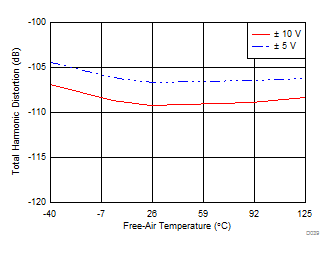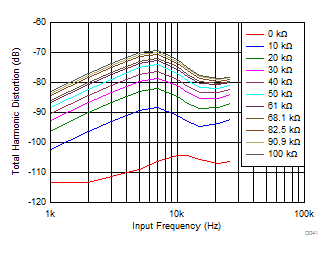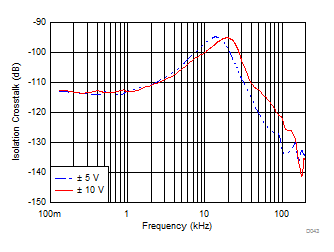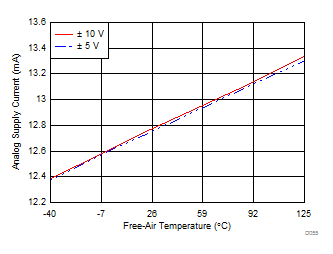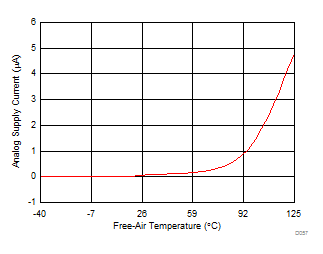SBAS827 September 2017 ADS8598S
PRODUCTION DATA.
- 1 Features
- 2 Applications
- 3 Description
- 4 Revision History
- 5 Pin Configuration and Functions
-
6 Specifications
- 6.1 Absolute Maximum Ratings
- 6.2 ESD Ratings
- 6.3 Recommended Operating Conditions
- 6.4 Thermal Information
- 6.5 Electrical Characteristics
- 6.6 Timing Requirements: CONVST Control
- 6.7 Timing Requirements: Data Read Operation
- 6.8 Timing Requirements: Parallel Data Read Operation, CS and RD Tied Together
- 6.9 Timing Requirements: Parallel Data Read Operation, CS and RD Separate
- 6.10 Timing Requirements: Serial Data Read Operation
- 6.11 Timing Requirements: Byte Mode Data Read Operation
- 6.12 Timing Requirements: Oversampling Mode
- 6.13 Timing Requirements: Exit Standby Mode
- 6.14 Timing Requirements: Exit Shutdown Mode
- 6.15 Switching Characteristics: CONVST Control
- 6.16 Switching Characteristics: Parallel Data Read Operation, CS and RD Tied Together
- 6.17 Switching Characteristics: Parallel Data Read Operation, CS and RD Separate
- 6.18 Switching Characteristics: Serial Data Read Operation
- 6.19 Switching Characteristics: Byte Mode Data Read Operation
- 6.20 Typical Characteristics
-
7 Detailed Description
- 7.1 Overview
- 7.2 Functional Block Diagram
- 7.3 Feature Description
- 7.4
Device Functional Modes
- 7.4.1
Device Interface: Pin Description
- 7.4.1.1 REFSEL (Input)
- 7.4.1.2 RANGE (Input)
- 7.4.1.3 STBY (Input)
- 7.4.1.4 PAR/SER/BYTE SEL (Input)
- 7.4.1.5 CONVSTA, CONVSTB (Input)
- 7.4.1.6 RESET (Input)
- 7.4.1.7 RD/SCLK (Input)
- 7.4.1.8 CS (Input)
- 7.4.1.9 OS[2:0]
- 7.4.1.10 BUSY (Output)
- 7.4.1.11 FRSTDATA (Output)
- 7.4.1.12 DB15/BYTE SEL
- 7.4.1.13 DB14/HBEN
- 7.4.1.14 DB[13:9]
- 7.4.1.15 DB8/DOUTB
- 7.4.1.16 DB7/DOUTA
- 7.4.1.17 DB[6:0]
- 7.4.2 Device Modes of Operation
- 7.4.1
Device Interface: Pin Description
- 8 Application and Implementation
- 9 Power Supply Recommendations
- 10Layout
- 11Device and Documentation Support
- 12Mechanical, Packaging, and Orderable Information
Package Options
Mechanical Data (Package|Pins)
- PM|64
Thermal pad, mechanical data (Package|Pins)
Orderable Information
6 Specifications
6.1 Absolute Maximum Ratings
at TA = 25°C (unless otherwise noted)(1)| MIN | MAX | UNIT | ||
|---|---|---|---|---|
| AVDD to AGND | –0.3 | 7.0 | V | |
| DVDD to AGND | –0.3 | 7.0 | V | |
| Analog input voltage to AGND(2) | –15 | 15 | V | |
| Digital input to AGND | –0.3 | DVDD + 0.3 | V | |
| REFIN to AGND | –0.3 | AVDD + 0.3 | V | |
| Input current to any pin except supplies(2) | –10 | 10 | mA | |
| Temperature | Operating | –40 | 125 | °C |
| Junction, TJ | 150 | |||
| Storage, Tstg | –65 | 150 | ||
(1) Stresses beyond those listed under Absolute Maximum Ratings may cause permanent damage to the device. These are stress ratings only, which do not imply functional operation of the device at these or any other conditions beyond those indicated under Recommended Operating Conditions. Exposure to absolute-maximum-rated conditions for extended periods may affect device reliability.
(2) Transient currents of up to 100 mA do not cause SCR latch-up.
6.2 ESD Ratings
| VALUE | UNIT | ||||
|---|---|---|---|---|---|
| V(ESD) | Electrostatic discharge | Human-body model (HBM), per ANSI/ESDA/JEDEC JS-001(1) |
All pins except analog inputs | ±2000 | V |
| Analog input pins only | ±9000 | ||||
| Charged-device model (CDM), per JEDEC specification JESD22-C101(2) |
±500 | ||||
(1) JEDEC document JEP155 states that 500-V HBM allows safe manufacturing with a standard ESD control process.
(2) JEDEC document JEP157 states that 250-V CDM allows safe manufacturing with a standard ESD control process.
6.3 Recommended Operating Conditions
over operating free-air temperature range (unless otherwise noted)| MIN | NOM | MAX | UNIT | ||
|---|---|---|---|---|---|
| AVDD | Analog supply voltage | 4.75 | 5 | 5.25 | V |
| DVDD | Digital supply voltage | 2.3 | 3.3 | AVDD | V |
6.4 Thermal Information
| THERMAL METRIC(1) | ADS8598S | UNIT | |
|---|---|---|---|
| PM (LQFP) | |||
| 64 PINS | |||
| RθJA | Junction-to-ambient thermal resistance | 46.0 | °C/W |
| RθJC(top) | Junction-to-case (top) thermal resistance | 7.8 | °C/W |
| RθJB | Junction-to-board thermal resistance | 20.1 | °C/W |
| ψJT | Junction-to-top characterization parameter | 0.3 | °C/W |
| ψJB | Junction-to-board characterization parameter | 19.6 | °C/W |
| RθJC(bot) | Junction-to-case (bottom) thermal resistance | N/A | °C/W |
(1) For more information about traditional and new thermal metrics, see the Semiconductor and IC Package Thermal Metrics application report.
6.5 Electrical Characteristics
minimum and maximum specifications are at TA = –40°C to +125°C, AVDD = 4.75 V to 5.25 V; typical specifications are at TA = 25°C; AVDD = 5 V, DVDD = 3 V, VREF = 2.5 V (internal), and fSAMPLE = 200 kSPS (unless otherwise noted)| PARAMETER | TEST CONDITIONS | MIN | TYP | MAX | UNIT | |||
|---|---|---|---|---|---|---|---|---|
| ANALOG INPUTS | ||||||||
| Full-scale input span(1)
(AIN_nP to AIN_nGND) |
RANGE pin = 1 | –10 | 10 | V | ||||
| RANGE pin = 0 | –5 | 5 | ||||||
| AIN_nP | Operating input range, positive input |
RANGE pin = 1 | –10 | 10 | V | |||
| RANGE pin = 0 | –5 | 5 | ||||||
| AIN_nGND | Operating input range, negative input |
All input ranges | –0.3 | 0 | 0.3 | V | ||
| RIN | Input impedance | At TA = 25°C | 0.85 | 1 | 1.15 | MΩ | ||
| Input impedance drift | All input ranges | –25 | ±7 | 25 | ppm/°C | |||
| IIkg(in) | Input leakage current | With voltage at AIN_nP = VIN, all input ranges |
(VIN – 2) / RIN | µA | ||||
| SYSTEM PERFORMANCE | ||||||||
| Resolution | 18 | Bits | ||||||
| NMC | No missing codes | 18 | Bits | |||||
| DNL | Differential nonlinearity | All input ranges | –0.9 | ±0.5 | 0.9 | LSB(2) | ||
| INL | Integral nonlinearity(4) | All input ranges | –5.5 | ±2 | 5.5 | LSB | ||
| EG | Gain error(8) | All input ranges, external reference |
TA = –40°C to +85°C | –256 | ±10 | 256 | LSB | |
| TA = –40°C to +125°C | –256 | ±10 | 300 | |||||
| All input ranges, internal reference |
±10 | |||||||
| Gain error matching (channel-to-channel) |
Input range = ±10 V, external and internal reference |
32 | 170 | LSB | ||||
| Input range = ±5 V, external and internal reference |
34 | 170 | ||||||
| Gain error temperature drift | All input ranges, external reference |
–14 | ±6 | 14 | ppm/°C | |||
| All input ranges, internal reference |
±10 | |||||||
| EO | Offset error | Input range = ±10 V | –1.8 | ±0.3 | 1.8 | mV | ||
| Input range = ±5 V | –1.8 | ±0.3 | 1.8 | |||||
| Offset error matching (channel-to-channel) |
All input ranges | 0.5 | 5 | mV | ||||
| Offset error temperature drift | All input ranges | –3 | ±0.3 | 3 | ppm/°C | |||
| SAMPLING DYNAMICS | ||||||||
| tACQ | Acquisition time | 1 | µs | |||||
| fS | Maximum throughput rate per channel without latency | All eight channels included | 200 | kSPS | ||||
| DYNAMIC CHARACTERISTICS | ||||||||
| SNR | Signal-to-noise ratio, no oversampling (VIN – 0.5 dBFS at 1 kHz) |
Input range = ±10 V | 92 | 94 | dB | |||
| Input range = ±5 V | 90.25 | 93.2 | ||||||
| SNROSR | Signal-to-noise ratio, oversampling = 16x (VIN – 0.5 dBFS at 130 Hz) |
Input range = ±10 V | 99.6 | 101.8 | dB | |||
| Input range = ±5 V | 97.4 | 99.2 | ||||||
| THD | Total harmonic distortion(3)
(VIN – 0.5 dBFS at 1 kHz) |
All input ranges | –109.2 | –95 | dB | |||
| SINAD | Signal-to-noise + distortion ratio, no oversampling (VIN – 0.5 dBFS at 1 kHz) |
Input range = ±10 V | 91.75 | 93.9 | dB | |||
| Input range = ±5 V | 90 | 93.1 | ||||||
| SINADOSR | Signal-to-noise + distortion ratio, oversampling = 16x (VIN – 0.5 dBFS at 130 Hz) |
Input range = ±10 V | 98.5 | 101 | dB | |||
| Input range = ±5 V | 96.6 | 98.9 | ||||||
| SFDR | Spurious-free dynamic range (VIN – 0.5 dBFS at 1 kHz) |
All input ranges | 109 | dB | ||||
| Crosstalk isolation(5) | –95 | dB | ||||||
| BW(–3 dB) | Small-signal bandwidth, –3 dB | At TA = 25°C, input range = ±10 V |
24 | kHz | ||||
| At TA = 25°C, input range = ±5 V |
16 | |||||||
| BW(–0.1 dB) | Small-signal bandwidth, –0.1 dB | At TA = 25°C, input range = ±10 V |
14 | kHz | ||||
| At TA = 25°C, input range = ±5 V |
9.5 | |||||||
| tGROUP | Group delay | Input range = ±10 V | 13 | µs | ||||
| Input range = ±5 V | 19 | |||||||
| INTERNAL REFERENCE OUTPUT (REFSEL = 1) | ||||||||
| VREF(6) | Voltage on the REFIN/REFOUT pin (configured as output) |
At TA = 25°C | 2.4975 | 2.5 | 2.5025 | V | ||
| Internal reference temperature drift | 7.5 | ppm/°C | ||||||
| C(REFIN_ REFOUT) | Decoupling capacitor on the REFIN/REFOUT pin(7) | 10 | µF | |||||
| V(REFCAP) | Reference voltage to the ADC (on the REFCAPA, REFCAPB pin) |
At TA = 25°C | 3.996 | 4.0 | 4.004 | V | ||
| Reference buffer output impedance | 0.5 | 1 | Ω | |||||
| Reference buffer output temperature drift | 5 | ppm/°C | ||||||
| C(REFCAP) | Decoupling capacitor on REFCAPA, REFCAPB | 10 | µF | |||||
| Turn-on time | C(REFCAP) = 10 µF, C(REFIN_REFOUT) = 10 µF |
25 | ms | |||||
| EXTERNAL REFERENCE INPUT (REFSEL = 0) | ||||||||
| VREFIO_EXT | External reference voltage on REFIO (configured as input) |
2.475 | 2.5 | 2.525 | V | |||
| Reference input impedance | 100 | MΩ | ||||||
| Reference input capacitance | 10 | pF | ||||||
| POWER-SUPPLY REQUIREMENTS | ||||||||
| AVDD | Analog power-supply voltage | Analog supply | 4.75 | 5 | 5.25 | V | ||
| DVDD | Digital power-supply voltage | Digital supply range | 2.3 | 3.3 | AVDD | V | ||
| IAVDD_DYN | Analog supply current (operational) |
AVDD = 5 V, fS = 200 kSPS, internal reference |
17.7 | 24 | mA | |||
| AVDD = 5 V, fS = 200 kSPS, external reference |
17.1 | 24 | ||||||
| IAVDD_STC | Analog supply current (static) |
AVDD = 5 V, internal reference, device not converting |
12.4 | 17 | mA | |||
| AVDD = 5 V, external reference, device not converting |
12 | 17 | ||||||
| IAVDD_STDBY | AVDD supply STANDBY current |
At AVDD = 5 V, device in STDBY mode, internal reference | 4.2 | 5.5 | mA | |||
| At AVDD = 5 V, device in STDBY mode, external reference | 3.8 | 5.0 | ||||||
| IAVDD_PWR_ DN | AVDD supply power-down current |
At AVDD = 5 V, device in PWR_DN, internal or external reference, TA = –40°C to +85°C |
0.2 | 6 | µA | |||
| IDVDD_DYN | Digital supply current | DVDD = 3.3 V, fS = 200 kSPS |
0.15 | 0.3 | mA | |||
| IDVDD_STDBY | DVDD supply STANDBY current | At AVDD = 5 V, device in STDBY mode | 0.05 | 1.5 | µA | |||
| IDVDD_PWR-DN | DVDD supply power-down current | At AVDD = 5 V, device in PWR_DN mode | 0.05 | 1.5 | µA | |||
| DIGITAL INPUTS (CMOS) | ||||||||
| VIH | Digital high input voltage logic level | DVDD > 2.3 V | 0.7 × DVDD | DVDD + 0.3 | V | |||
| VIL | Digital low input voltage logic level | DVDD > 2.3 V | –0.3 | 0.3 × DVDD | V | |||
| Input leakage current | 100 | nA | ||||||
| Input pin capacitance | 5 | pF | ||||||
| DIGITAL OUTPUTS (CMOS) | ||||||||
| VOH | Digital high output voltage logic level | IO = 100-µA source | 0.8 × DVDD | DVDD | V | |||
| VOL | Digital low output voltage logic level | IO = 100-µA sink | 0 | 0.2 × DVDD | V | |||
| Floating state leakage current | Only for SDO | 1 | µA | |||||
| Internal pin capacitance | 5 | pF | ||||||
| TEMPERATURE RANGE | ||||||||
| TA | Operating free-air temperature | –40 | 125 | °C | ||||
(1) Ideal input span, does not include gain or offset error.
(2) LSB = least significant bit.
(3) Calculated on the first nine harmonics of the input frequency.
(4) This parameter is the endpoint INL, not best-fit INL.
(5) Isolation crosstalk is measured by applying a full-scale sinusoidal signal up to 160 kHz to a channel, not selected in the multiplexing sequence, and measuring the effect on the output of any selected channel.
(6) Does not include the variation in voltage resulting from solder shift effects.
(7) Recommended to use an X7R-grade, 0603-size ceramic capacitor for optimum performance (see the Layout Guidelines section).
(8) Gain error is calculated after adjusting for offset error, which implies that positive full scale error = negative full scale error = gain error ÷ 2.
6.6 Timing Requirements: CONVST Control
minimum and maximum specifications are at TA = –40°C to +125°C, typical specifications are at TA = 25°C; AVDD = 5 V, 2.3 V ≤ DVDD ≤ 5.25 V, VREF = 2.5 V (internal), BUSY load = 20 pF, VIL and VIH at specified limits, and fSAMPLE = 200 kSPS (unless otherwise noted) (see Figure 1)| MIN | NOM | MAX | UNIT | ||
|---|---|---|---|---|---|
| tACQ | Acquisition time: BUSY falling edge to rising edge of trailing CONVSTA or CONVSTB |
1 | µs | ||
| tPH_CN | CONVSTA, CONVSTB pulse high time | 25 | ns | ||
| tPL_CN | CONVSTA, CONVSTB pulse low time | 25 | ns | ||
| tSU_BSYCS | Setup time: BUSY falling to CS falling | 0 | ns | ||
| tSU_RSTCN | Setup time: RESET falling to first rising edge of CONVSTA or CONVSTB | 25 | ns | ||
| tPH_RST | RESET pulse high time | 50 | ns | ||
| tD_CNAB | Delay between rising edges of CONVSTA and CONVSTB | 500 | µs | ||
6.7 Timing Requirements: Data Read Operation
minimum and maximum specifications are at TA = –40°C to +125°C, typical specifications are at TA = 25°C; AVDD = 5 V, 2.3 V ≤ DVDD ≤ 5.25 V, VREF = 2.5 V (internal), BUSY load = 20 pF, VIL and VIH at specified limits, and fSAMPLE = 200 kSPS (unless otherwise noted) (see Figure 2)| MIN | NOM | MAX | UNIT | ||
|---|---|---|---|---|---|
| tDZ_CNCS | Delay between CONVSTA, CONVSTB rising edge to CS falling edge, start of data read operation during conversion | 10 | ns | ||
| tDZ_CSBSY | Delay between CS rising edge to BUSY falling edge, end of data read operation during conversion | 40 | ns | ||
| tSU_BSYCS | Setup time: BUSY falling edge to CS falling edge, start of data read operation after conversion | 0 | ns | ||
| tD_CSCN | Delay between CS rising edge to CONVSTA, CONVSTB rising edge, end of data read operation after conversion | 10 | ns | ||
6.8 Timing Requirements: Parallel Data Read Operation, CS and RD Tied Together
minimum and maximum specifications are at TA = –40°C to +125°C, typical specifications are at TA = 25°C; AVDD = 5 V, 2.3 V ≤ DVDD ≤ 5.25 V, VREF = 2.5 V (internal), load on DB[15:0] and FRSTDATA = 20 pF, VIL and VIH at specified limits, and fSAMPLE = 200 kSPS (unless otherwise noted) (see Figure 3)| MIN | NOM | MAX | UNIT | |||
|---|---|---|---|---|---|---|
| tPH_CS, tPH_RD | CS and RD high time | 15 | ns | |||
| tPL_CS, tPL_RD | CS and RD low time | 15 | ns | |||
| tHT_RDDB, tHT_CSDB | Hold time: RD and CS rising edge to DB[15:0] invalid | 2.5 | ns | |||
6.9 Timing Requirements: Parallel Data Read Operation, CS and RD Separate
minimum and maximum specifications are at TA = –40°C to +125°C, typical specifications are at TA = 25°C; AVDD = 5 V, 2.3 V ≤ DVDD ≤ 5.25 V, VREF = 2.5 V (internal), load on DB[15:0] and FRSTDATA = 20 pF, VIL and VIH at specified limits, and fSAMPLE = 200 kSPS (unless otherwise noted) (see Figure 4)| MIN | NOM | MAX | UNIT | |||
|---|---|---|---|---|---|---|
| tSU_CSRD | Set-up time: CS falling edge to RD falling edge | 0 | ns | |||
| tHT_RDCS | Hold time: RD rising edge to CS rising edge | 0 | ns | |||
| tPL_RD | RD low time | 15 | ns | |||
| tPH_RD | RD high time | 15 | ns | |||
| tHT_CSDB | Hold time: CS rising edge to DB[15:0] becoming invalid | 6 | ns | |||
| tHT_RDDB | Hold time: RD rising edge to DB[15:0] becoming invalid | 2.5 | ns | |||
6.10 Timing Requirements: Serial Data Read Operation
minimum and maximum specifications are at TA = –40°C to +125°C, typical specifications are at TA = 25°C; AVDD = 5 V, 2.3 V ≤ DVDD ≤ 5.25 V, VREF = 2.5 V (internal), load on DOUTA, DOUTB, and FRSTDATA = 20 pF, VIL and VIH at specified limits, and fSAMPLE = 200 kSPS (unless otherwise noted) (see Figure 5)| MIN | NOM | MAX | UNIT | |||
|---|---|---|---|---|---|---|
| tSCLK | SCLK time period | 50 | ns | |||
| tPH_SCLK | SCLK high time | 0.45 | 0.55 | tSCLK | ||
| tPL_SCLK | SCLK low time | 0.45 | 0.55 | tSCLK | ||
| tHT_CKDO | Hold time: SCLK rising edge to DOUTA, DOUTB invalid | 7 | ns | |||
| tSU_CSCK | Setup time: CS falling to first SCLK edge | 8 | ns | |||
| tHT_CKCS | Hold time: last SCLK active edge to CS high | 10 | ns | |||
6.11 Timing Requirements: Byte Mode Data Read Operation
minimum and maximum specifications are at TA = –40°C to +125°C, typical specifications are at TA = 25°C; AVDD = 5 V, 2.3 V ≤ DVDD ≤ 5.25 V, VREF = 2.5 V (internal), load on DB[7:0] and FRSTDATA = 20 pF, VIL and VIH at specified limits, and fSAMPLE = 200 kSPS (unless otherwise noted) (see Figure 6)| MIN | NOM | MAX | UNIT | |||
|---|---|---|---|---|---|---|
| tSU_CSRD | Setup time: CS falling edge to RD falling edge | 0 | ns | |||
| tHT_RDCS | Hold time: RD rising edge to CS rising edge | 0 | ns | |||
| tPL_RD | RD low time | 15 | ns | |||
| tPH_RD | RD high time | 15 | ns | |||
| tHT_CSDB | Hold time: CS rising edge to DB[15:0] becoming invalid | 6 | ns | |||
| tHT_RDDB | Hold time: RD rising edge to DB[15:0] becoming invalid | 2.5 | ns | |||
6.12 Timing Requirements: Oversampling Mode
minimum and maximum specifications are at TA = –40°C to +125°C, typical specifications are at TA = 25°C; AVDD = 5 V, 2.3 V ≤ DVDD ≤ 5.25 V, VREF = 2.5 V (internal), VIL and VIH at specified limits, and fSAMPLE = 200 kSPS (unless otherwise noted) (see Figure 7)| MIN | NOM | MAX | UNIT | ||
|---|---|---|---|---|---|
| tHT_OS | Hold time: BUSY falling to OSx | 20 | ns | ||
| tSU_OS | Setup time: BUSY falling to OSx | 20 | ns | ||
6.13 Timing Requirements: Exit Standby Mode
minimum and maximum specifications are at TA = –40°C to +125°C, typical specifications are at TA = 25°C, AVDD = 5 V, 2.3 V ≤ DVDD ≤ 5.25 V, VREF = 2.5 V (internal), VIL and VIH at specified limits, and fSAMPLE = 200 kSPS (unless otherwise noted) (see Figure 8)| MIN | NOM | MAX | UNIT | ||
|---|---|---|---|---|---|
| tD_STBYCN | Delay between STBY rising edge to CONVSTA or CONVSTB rising edge(1) | 100 | µs | ||
(1) First conversion data must be discarded or RESET must be issued if the maximum timing is exceeded.
6.14 Timing Requirements: Exit Shutdown Mode
minimum and maximum specifications are at TA = –40°C to +125°C, typical specifications are at TA = 25°C; AVDD = 5 V, 2.3 V ≤ DVDD ≤ 5.25 V, VREF = 2.5 V (internal), VIL and VIH at specified limits, and fSAMPLE = 200 kSPS (unless otherwise noted) (see Figure 9)| MIN | NOM | MAX | UNIT | |||
|---|---|---|---|---|---|---|
| tD_SDRST | Delay between STBY rising edge to RESET rising edge | Internal reference mode | 50 | ms | ||
| External reference mode(1) | 13 | |||||
| tPH_RST | RESET high time | 50 | ns | |||
| tD_RSTCN | Delay between RESET falling edge to CONVSTA or CONVSTB rising edge | 25 | µs | |||
(1) Excludes wake-up time for external reference device.
6.15 Switching Characteristics: CONVST Control
minimum and maximum specifications are at TA = –40°C to +125°C, typical specifications are at TA = 25°C; AVDD = 5 V, 2.3 V ≤ DVDD ≤ 5.25 V, VREF = 2.5 V (internal), BUSY load = 20 pF, VIL and VIH at specified limits, and fSAMPLE = 200 kSPS (unless otherwise noted) (see Figure 1)| PARAMETER | TEST CONDITIONS | MIN | TYP | MAX | UNIT | |
|---|---|---|---|---|---|---|
| tCYC | ADC cycle time period | No oversampling, parallel read, serial read with both DOUTA and DOUTB during conversion | 5 | µs | ||
| No oversampling, serial read after conversion with both DOUTA and DOUTB | 9.7 | |||||
| No oversampling, serial read after conversion with only DOUTA or DOUTB | 15 | |||||
| tCONV | Conversion time: BUSY high time | No oversampling | 3.7 | 3.8 | 3.9 | µs |
| Oversampling by 2 | 8.4 | 8.8 | ||||
| Oversampling by 4 | 17 | 18 | ||||
| Oversampling by 8 | 34 | 36 | ||||
| Oversampling by 16 | 68 | 72 | ||||
| Oversampling by 32 | 136 | 144 | ||||
| Oversampling by 64 | 272 | 288 | ||||
| tD_CNBSY | Delay between trailing rising edges of CONVSTA or CONVSTB and BUSY rising | 15 | ns | |||
6.16 Switching Characteristics: Parallel Data Read Operation, CS and RD Tied Together
minimum and maximum specifications are at TA = –40°C to +125°C, typical specifications are at TA = 25°C; AVDD = 5 V, 2.3 V ≤ DVDD ≤ 5.25 V, VREF = 2.5 V (internal), load on DB[15:0] and FRSTDATA = 20 pF, VIL and VIH at specified limits, and fSAMPLE = 200 kSPS (unless otherwise noted) (see Figure 3)| PARAMETER | TEST CONDITIONS | MIN | TYP | MAX | UNIT | |
|---|---|---|---|---|---|---|
| tD_CSDB, tD_RDDB | Delay time: CS and RD falling edge to DB[15:0] becoming valid (out of tri-state) |
12 | ns | |||
| tD_CSFD, tD_RDFD | Delay time: CS and RD falling edge to FRSTDATA going high or low out of tri-state | 10 | ns | |||
| tDHZ_CSDB, tDHZ_RDDB | Delay time: CS and RD rising edge to DB[15:0] tri-state | 12 | ns | |||
| tDHZ_CSFD, tDHZ_RDFD | Delay time: CS and RD rising edge to FRSTDATA tri-state | 10 | ns | |||
6.17 Switching Characteristics: Parallel Data Read Operation, CS and RD Separate
minimum and maximum specifications are at TA = –40°C to +125°C, typical specifications are at TA = 25°C; AVDD = 5 V, 2.3 V ≤ DVDD ≤ 5.25 V, VREF = 2.5 V (internal), load on DB[15:0] and FRSTDATA = 20 pF, VIL and VIH at specified limits, and fSAMPLE = 200 kSPS (unless otherwise noted) (see Figure 4)| PARAMETER | TEST CONDITIONS | MIN | TYP | MAX | UNIT | |
|---|---|---|---|---|---|---|
| tD_CSDB | Delay time: CS falling edge to DB[15:0] becoming valid (out of tri-state) |
12 | ns | |||
| tD_RDDB | Delay time: RD falling edge to new data on DB[15:0] | 17 | ns | |||
| tDHZ_CSDB | Delay time: CS rising edge to DB[15:0] becoming tri-state | 12 | ns | |||
| tD_CSFD | Delay time: CS falling edge to FRSTDATA going low out of tri-state | 15 | ns | |||
| tDHZ_CSFD | Delay time: CS rising edge to FRSTDATA going to tri-state | 10 | ns | |||
| tD_RDFD | Delay time: RD falling edge to FRSTDATA going high or low | 15 | ns | |||
6.18 Switching Characteristics: Serial Data Read Operation
minimum and maximum specifications are at TA = –40°C to +125°C, typical specifications are at TA = 25°C; AVDD = 5 V, 2.3 V ≤ DVDD ≤ 5.25 V, VREF = 2.5 V (internal), load on DOUTA, DOUTB, and FRSTDATA = 20 pF, VIL and VIH at specified limits, and fSAMPLE = 200 kSPS (unless otherwise noted) (see Figure 5)| PARAMETER | TEST CONDITIONS | MIN | TYP | MAX | UNIT | |
|---|---|---|---|---|---|---|
| tD_CSDO | Delay time: CS falling edge to DOUTA, DOUTB enable (out of tri-state) |
12 | ns | |||
| tD_CKDO | Delay time: SCLK rising edge to valid data on DOUTA, DOUTB | 15 | ns | |||
| tDZ_CSDO | Delay time: CS rising edge to DOUTA, DOUTB going to tri-state | 12 | ns | |||
| tD_CSFD | Delay time: CS falling edge to FRSTDATA from tri-state to high or low | 10 | ns | |||
| tDZ_CKFD | Delay time: 18th SCLK falling edge to FRSTDATA falling edge | 15 | ns | |||
| tDHZ_CSFD | Delay time: CS rising edge to FRSTDATA going to tri-state | 10 | ns | |||
6.19 Switching Characteristics: Byte Mode Data Read Operation
minimum and maximum specifications are at TA = –40°C to +125°C, typical specifications are at TA = 25°C; AVDD = 5 V, 2.3 V ≤ DVDD ≤ 5.25 V, VREF = 2.5 V (internal), load on DB[7:0] and FRSTDATA = 20 pF, VIL and VIH at specified limits, and fSAMPLE = 200 kSPS (unless otherwise noted) (see Figure 6)| PARAMETER | TEST CONDITIONS | MIN | TYP | MAX | UNIT | ||
|---|---|---|---|---|---|---|---|
| tD_CSDB | Delay time: CS falling edge to DB[7:0] becoming valid (out of tri-state) |
12 | ns | ||||
| tD_RDDB | Delay time: RD falling edge to new data on DB[7:0] | 17 | ns | ||||
| tDHZ_CSDB | Delay time: CS rising edge to DB[7:0] becoming tri-state | 12 | ns | ||||
| tD_CSFD | Delay time: CS falling edge to FRSTDATA going low out of tri-state | 10 | ns | ||||
| tD_RDFD | Delay time: RD falling edge to FRSTDATA going low or high state | 15 | ns | ||||
| tDHZ_CSFD | Delay time: CS rising edge to FRSTDATA going to tri-state | 10 | ns | ||||
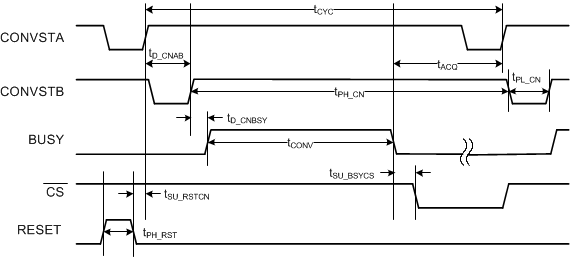 Figure 1. CONVST Control Timing Diagram
Figure 1. CONVST Control Timing Diagram
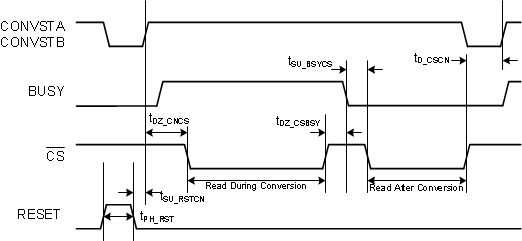 Figure 2. Data Read Operation Timing Diagram
Figure 2. Data Read Operation Timing Diagram
 Figure 3. Parallel Data Read Operation, CS and RD Tied Together
Figure 3. Parallel Data Read Operation, CS and RD Tied Together
 Figure 4. Parallel Data Read Operation, CS and RD Separate
Figure 4. Parallel Data Read Operation, CS and RD Separate
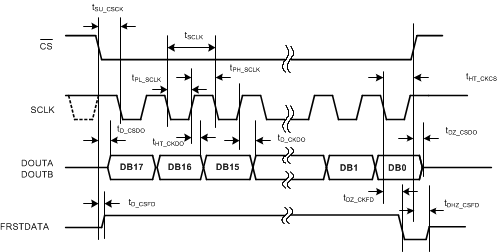 Figure 5. Serial Data Read Operation Timing Diagram
Figure 5. Serial Data Read Operation Timing Diagram
 Figure 6. Byte Mode Data Read Operation Timing Diagram
Figure 6. Byte Mode Data Read Operation Timing Diagram
 Figure 7. Oversampling Mode Timing Diagram
Figure 7. Oversampling Mode Timing Diagram
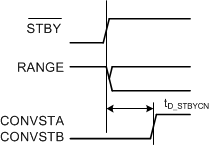 Figure 8. Exit Standby Mode Timing Diagram
Figure 8. Exit Standby Mode Timing Diagram
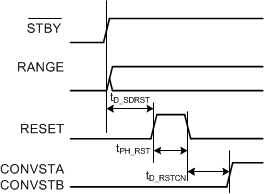 Figure 9. Exit Shutdown Mode Timing Diagram
Figure 9. Exit Shutdown Mode Timing Diagram
6.20 Typical Characteristics
at TA = 25°C, AVDD = 5 V, DVDD = 3 V, internal reference VREF = 2.5 V, and fS = 200 kSPS per channel (unless otherwise noted)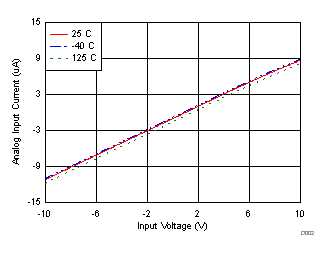
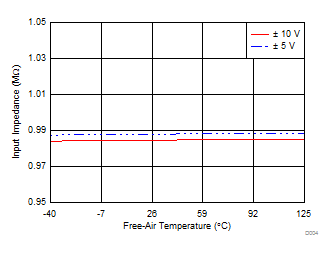
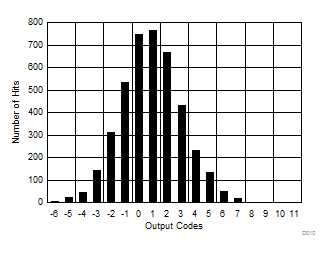
| Mean = 0.86, sigma = 2.1, number of hits = 4096, VIN = 0 V |
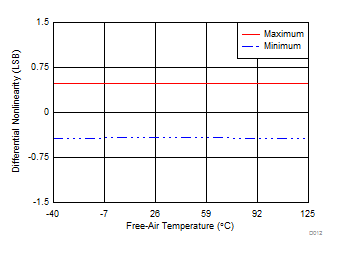
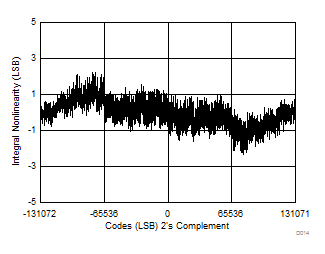
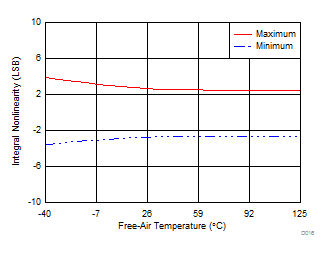
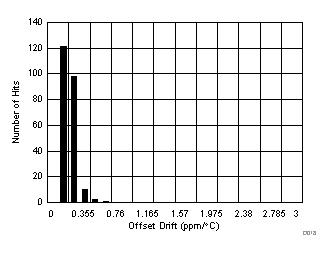
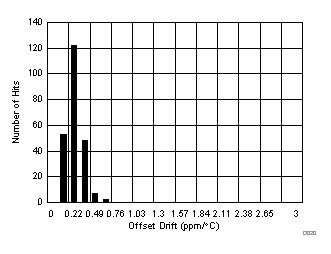
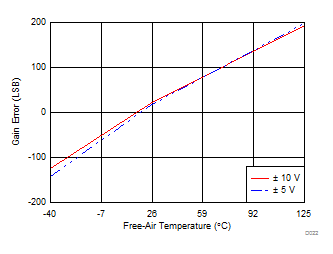
| External reference |
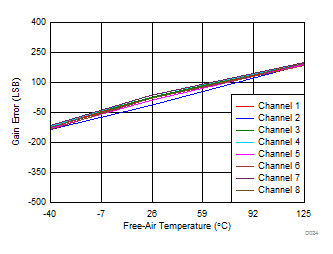
| External reference |
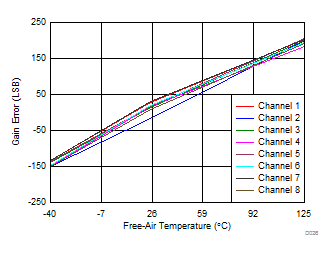
| External reference |
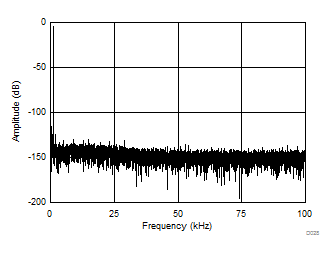
| Number of points = 256k, SNR = 93.77 dB, SINAD = 93.52 dB, THD = –105.93, SFDR = 106.98 dB |
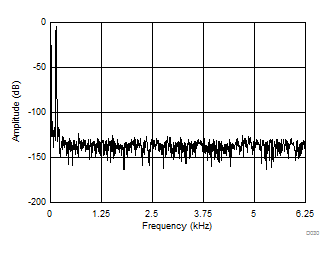
| Number of points = 256k, SNR = 100.48 dB, SINAD = 99.9 dB, THD = –105.93 dB, SFDR = 106.21 dB |
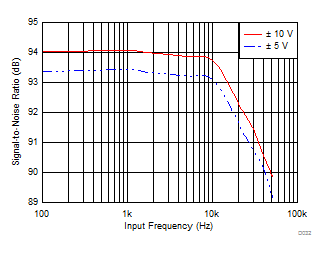
| OSR = 0 |
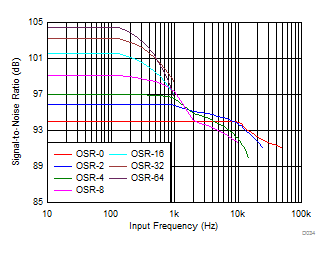
(±10 V)
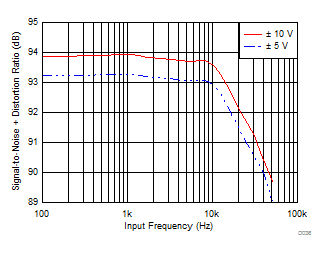
| OSR = 0 |
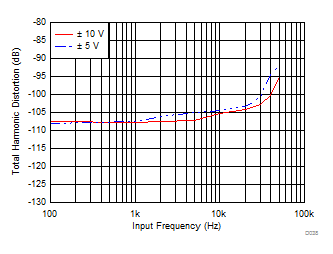
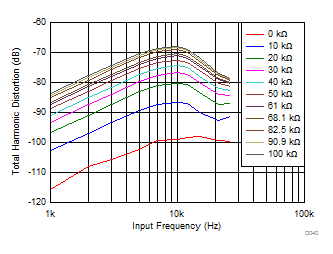
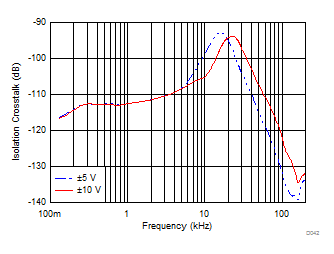
(Inputs Within Range)
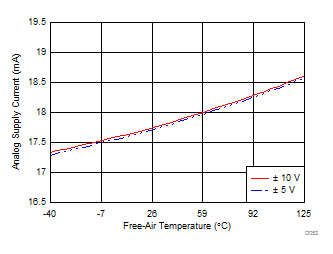
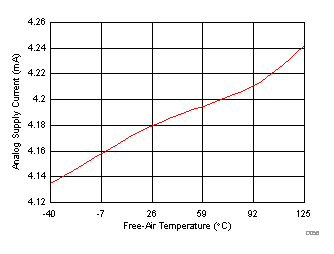
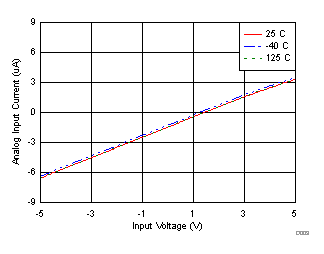
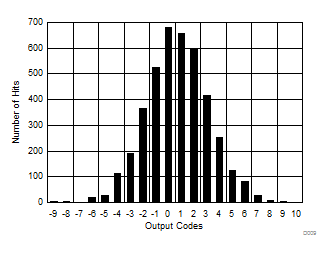
| Mean = 0.71, sigma = 1.83, number of hits = 4096, VIN = 0 V |
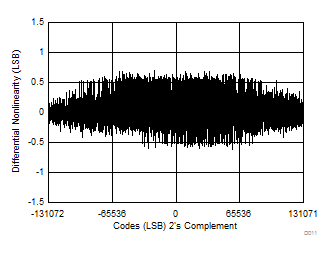
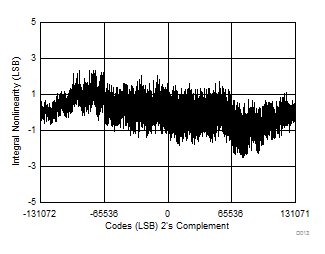
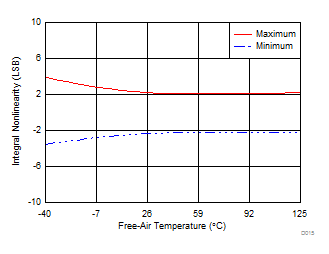
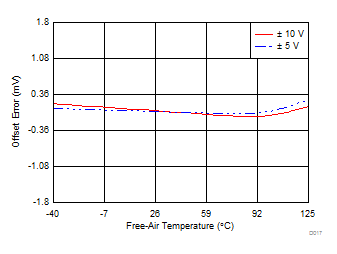
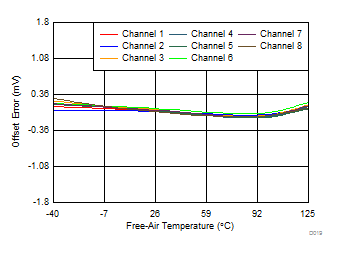
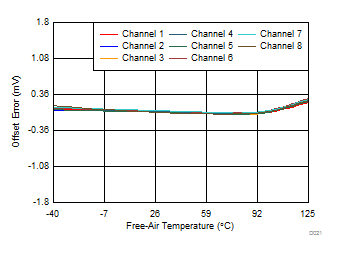
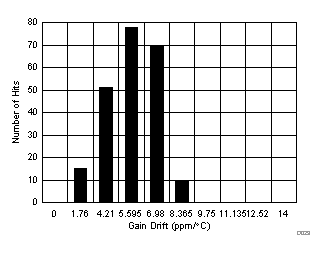
| External reference |
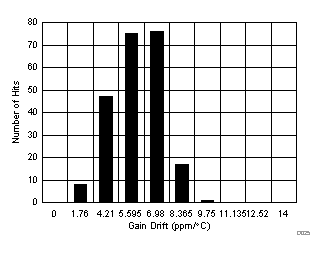
| External reference |
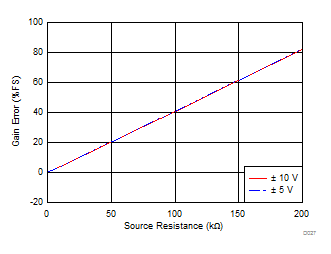
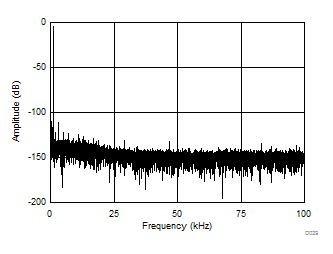
| Number of points = 256k, SNR = 92.45 dB, SINAD = 92.26 dB, THD = –105.85 dB, SFDR = 107.12 dB |
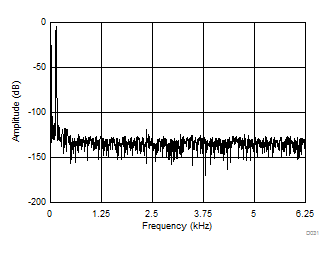
| Number of points = 256k, SNR = 99.26 dB, SINAD = 98.63 dB, THD = –105.84 dB, SFDR = 105.94 dB |
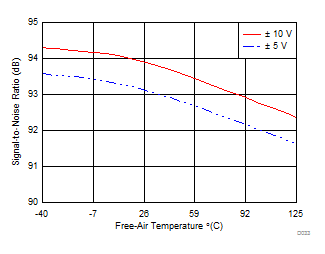
| OSR = 0 |
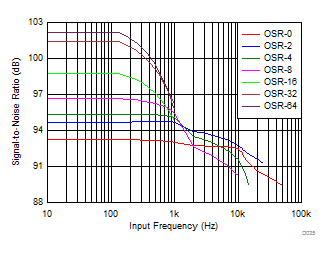
(±5 V)
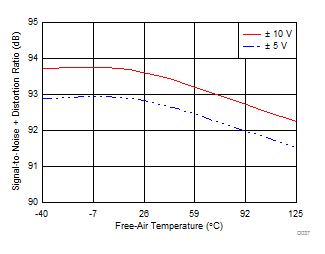
| OSR = 0 |
